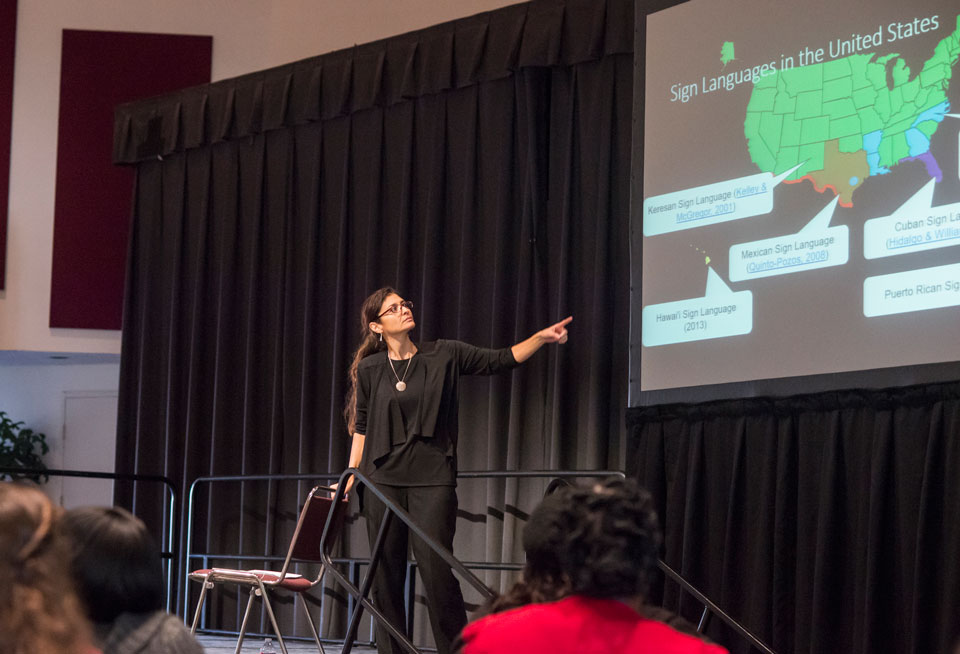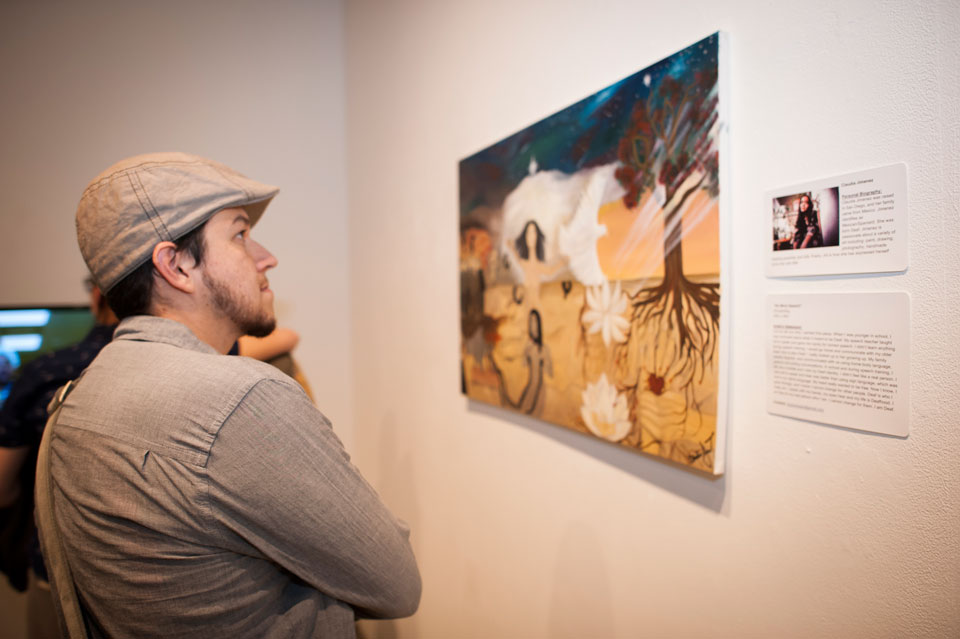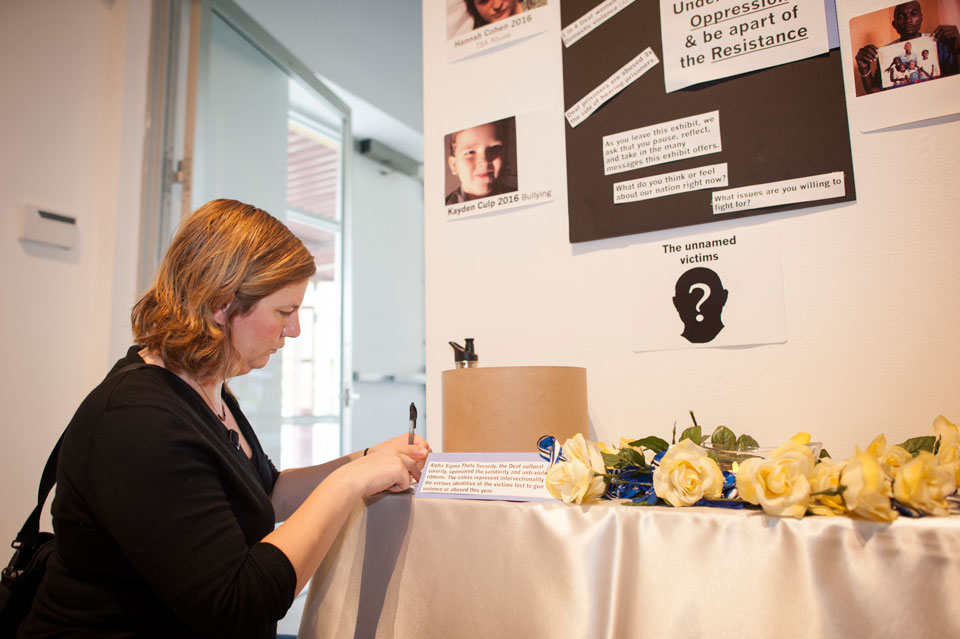CSUN’s Seventh Social Justice Conference Focuses on Experiences of Deaf Individuals
California State University, Northridge’s Department of Deaf Studies, the Deaf Studies Association and the National Center on Deafness hosted the seventh annual Social Justice: BY, FOR, OF People conference on Oct. 28 at the University Student Union.
The daylong discussion on the Deaf experience centered on intersectionality — the complexities in experience faced by individuals who identify with more than one marginalized group — and was open to all CSUN students, faculty, staff and people from the community. Nearly 400 visitors attended the event.
Speakers covered topics including racism, sexism, the Deaf Chicana/o experience, the diversity of signing communities and signing communities in rural Mexico.
Nancy Mendoza, a senior in deaf studies, took her day off to attend the conference.
“Events like this are important because there are still so many misconceptions about not only the Deaf community, but also minority groups in general,” she said.
Mendoza said she aspires to work with Deaf Chicana/o children after graduation and was excited to hear speaker Rogelio Fernández, president of Council de Manos, a national organization that serves the Deaf Chicana/o population.
“Education is so important,” Mendoza said. “[Fernández and Council de Manos] do so much and provide role models for young Deaf individuals so they can think, ‘there are things I can do’ and ‘I can be more than just a Deaf child.’”
Other featured speakers were Renzenet Moges-Riede, a Deaf Eritrean-American linguistic anthropologist; Lynn “Lina” Hou, a theoretical linguistics, linguistic anthropology and deaf studies researcher, and keynote speaker Carla García-Fernández, equity consultant and co-founder of Teachers for Social Justice: Deaf Learners Inc., a nonprofit organization supporting teachers who work with Deaf and hard-of-hearing learners.
“I was always told to conform to the hearing world and to read and write clearly because speech is an important vehicle to make change in the world,” said Carla García-Fernández, who grew up in New Mexico as one of eight children.
She shared her own experience as a member of the Deaf and Chicana/o community, as well as her research on marginalized students of the Deaf and Chicana/o community. Fernández shared her observations on the segregation between white Deaf and hard-of-hearing students and Deaf and hard-of-hearing students of color, advocating for anti-bias education.
“Why are we ranking certain Deaf people over other Deaf people, when we’re all in need of equality?” she asked. “All students need to be instructed and all students need to be respected.”
During the event’s lunch break, attendees were encouraged to visit CSUN’s West Gallery – located on North University Drive between Lindley and Etiwanda Street – to view the Justice Can’t Wait art exhibition, featuring the works of Deaf artists of color.
“With this exhibit, we wanted to show the talent of our Deaf people of color,” said CSUN deaf studies professor Lissa Stapleton, who co-curated the event. “We’re using art to educate others and keep it as open as possible for everyone.”
The free exhibit featured paintings, poetry, videos and other mediums of expression that illustrated different issues and perspectives of Deaf people of color.
“Deaf studies can be a very white field, and some voices can be left out,” Stapleton said. “This exhibit centers on Deaf people of color to highlight their experiences.”
Many art pieces featured themes of depression, resistance or social justice issues faced by the artists themselves. Another common theme was violence and police brutality. CSUN’s Deaf sorority, Alpha Sigma Theta, created an altar at the exhibit to honor the lives of violated and murdered Deaf people. Visitors were encouraged to take a blue and silver ribbon to show their solidarity with the Deaf victims.
William Garrow, CSUN deaf studies professor and an organizer of the social justice conference, explained that the event has grown since its first year, 2010, when the event originated as Stop Audism — later changing its name to Social Justice: BY, FOR, OF People in 2015. Audism is a term for the social construct oppressing Deaf people, which leads to a system of overprivilege for hearing people and underprivilege for Deaf people.
“The only way to liberate Deaf people from the bondage of audism is to liberate all people from various forms of oppression that are running rampant in our society,” Garrow said. “We cannot have liberation of one if we don’t have liberation for all.”
Garrow was the first hearing person to attend Gallaudet University in Washington, D.C., which is the world’s only university designed for Deaf students. By including all marginalized communities in the discussion of the event, Garrow said he hoped to highlight the concept of intersectionality, which recognizes people’s membership in various groups and identities.
“This [conference] is a deaf-centric space, but it is a zone of resistance from all forms of oppression,” he said. “We are trying our best to [eradicate oppression] at all times, and this conference is one way.”





 experience
experience